WINTER FEEDING TIPS
With winter grazing on short supply for some states, here are some ways to increase efficiency and decrease waste when feeding cattle this winter.
7 COVER CROPS
This family farm improves their cattle health and soil nutrition by keeping a root in the ground all year.
ESA LISTING
NCBA is disappointed in the listing of the Lesser Prairie Chicken under the Endangered Species Act.
FEDERATION
As we celebrate the Federation’s 60th anniversary, we begin with the birth of the Federation in the 1960s.
CHECKOFF
The Beef Checkoff utilizes relationships with influential Registered Dietitian Nutritionists to spread the positive health benefits of beef.
Feeding the Rockies with Ground Beef
product on people’s plates.”
As we wrap up the holidays, it is good to remember that the “season of giving” should extend beyond when we are simply in the Christmas spirit. Janie VanWinkle, her husband, Howard, and son, Dean, are great examples of giving year-round. In 2022, they partnered with the Food Bank of the Rockies to provide them with more than 40,000 pounds of ground beef at a discounted price. The Food Bank of the Rockies is a non-profit that supplies many of the local food banks in Colorado. The VanWinkles plan to continue this partnership in 2023.
VanWinkle Ranch LLC is located near Grand Junction, Colorado, where Janie and Howard operate the ranch fulltime. In 2017, the couple set out to achieve their goal to add value to their cow herd by feeding out their cull cows, adding marbling, and selling them as ground beef to local consumers.
How did it begin?
Janie and Howard didn’t always work full-time on the ranch. When Janie graduated from Colorado State University in 1983 with a degree in agricultural education, and Howard finished mechanics school, they returned to Grand Junction and found jobs in town. Janie worked in a department store initially and Howard as a mechanic. Later, Janie was hired to open a Barnes & Noble store. After seven years as the store manager, Janie wanted to operate her own business, so she opened a Nick-N’-Willy’s Pizza franchise. Janie owned Nick-N-Willy’s for 10 years, and she attributes her strong connection to her community to owning the restaurant.
“One of the biggest things that came out of owning the store was learning how to do community-based marketing and learning how to connect the business to the community,” Janie said. “Our direct-to-consumer program evolved from those relationships.”
Owning the restaurant gave her credibility with local organizations, businesses and consumers. Through giving back to local student clubs and organizations, Janie built trust and camaraderie amongst her community.
For 35 years, Janie and Howard worked in town and built their cow herd, which started as just 20 head, by leasing small pieces of land in the area to graze their cattle on. As the herd grew, it became more challenging to manage their cattle and careers. In 2010, Howard sold his share of the automotive shop he owned with his brother and by 2012 he was full-time on the ranch. After owning Nick-N’-Willy’s for 10 years and three weeks, Janie sold the restaurant and joined her husband on the ranch in 2015.
When did you start selling ground beef?
“In 2017, we set a goal to sell all of our cull cows through our ground beef program,” Janie said. “The goal started as a cow a month. We realized we could add value to these cull cows by feeding them for 60 days and putting a really good
In the beginning, it was a small direct-to-consumer business while they sold ground beef out of their freezer. Now, the VanWinkles have a designated area to finish their cull cows on either a hay or grain ration, depending on their end destination, and they send them to be harvested at Mountain Meat Packing in Fruita, Colorado. All the beef sold to the food bank is hay-finished while the beef sold directto-consumer is grain finished.
“It’s a partnership between livestock producers and meat packers. We have to make sure we have our product tested and what we are doing is producing safe food for the food banks, and the VanWinkles produce good, healthy cattle,” said Gary Baysinger, owner of Mountain Meats.
It took them two years to reach their goal of harvesting a cow per month. When COVID-19 hit, consumers found their grocery store shelves empty and Janie sold 2,000 pounds of ground beef in a matter of two months. When did you start working with food banks?
“It sort of evolved, as most things do. In the fall of 2020, I started selling to local church food banks first, 100 pounds here and 200 pounds there,” Janie explained.
VanWinkle Ranch was selling their ground beef at a large discount to four small food banks, but Janie realized that many of Colorado’s food banks are supplied by Food Bank of the Rockies, which has a distribution center nearby in Palisade, Colorado. They contacted Hannah Moore on the sourcing team for Food Bank of the Rockies and established an agreement to supply the Palisade distribution center with high-quality ground beef.
“Working with VanWinkle Ranch has been a great experience. Janie has done everything she can to make the ground beef we purchase from VanWinkle Ranch accessible so we can provide good food to our communities,” said Moore.
In 2021, they were selling 1,000-2,000 pounds of ground beef to the Food Bank of the Rockies, as needed. However, the system was inconsistent, so in December 2021, the Food Bank told the VanWinkles they wanted 2,000 pounds every month for 2022. Going forward, they increased the agreement to 4,000 pounds a month for 2023.

In the beginning of the VanWinkles’ relationship with Food Bank of the Rockies there were challenges to logistics and communication. Creating a smooth-working system took trial and error but has improved with consistent monthly orders for beef that is picked up from Mountain Meats by truck.

What is the impact in the community?
Janie and Howard are well-known in their community from their time working in town, owning businesses, and their involvement with the food banks. Every year, they donate an entire beef cow to one local organization, with Mountain Meats donating the processing. It makes a difference to see a local rancher partnering with community programs and allows community members to see the way the VanWinkles tend and care for their land. They steward their cattle and land with respect and thought to future generations.
One organization they have donated to over the years is
NATIONAL CATTLEMEN To be the trusted leader and definitive voice of the U.S. cattle and beef industry. PRSRT STD US POSTAGE PAID HATTIESBURG, MS PERMIT 142 NATIONAL CATTLEMEN’S BEEF ASSOCIATION 9110 E. NICHOLS AVENUE, SUITE 300 CENTENNIAL, CO 80112 JANUARY 2023 • Vol. 39, No. 3 • NCBA.org SOUTH CENTRAL 500-600 LB. STEERS WEEK OF 12/19/2022 IN THIS ISSUE $195.13 11.96% $174.28 $155.56 13.4% $137.19 LIVE FED STEERS $255.83 2.4% $262.04 CHOICE BOXED BEEF $7.04 17.6% $5.98 OMAHA CASH CORN 4 NEW GENERATIONS
6
10
Continued on page 4 CURRENT
14
Brandon DuBois is building a legacy for his children and his state cattlemen’s association as a first-generation cattle farmer and a business owner.
VS. LAST YEAR MARKET SNAPSHOT
15
NEWS
The National Corn Growers Association has been the sole sponsor of the Cattlemen Education Series for the past three years. What initially began as exclusively an opportunity to provide grant-style funding to education sessions at the state level, has evolved to include webinars, podcasts, and now three episodes of Cattlemen to Cattlemen on RFD-TV. Though our partnership itself has evolved, much like our industries, our mission remains the same: striving to bring the latest and greatest industry news to America’s farmers and ranchers.




So, why beef and corn? Well, we can think of many reasons, but we’ll give you our top three! First, 1 out of 4 bushels of added corn demand
is due to red meat exports, and that translates to added value and opportunity for both beef and corn producers. Secondly, the beef industry is our #1 customer in the livestock sector, consuming over 1,500 million bushels of corn in 2022. Lastly, what happens in the corn fields directly impacts what happens beyond the gate. We recognize that advancements in corn’s sustainability, directly improves the overall sustainability of beef. This means that consumers can still buy the delicious, well marbled cornfed beef they crave. You can count on NCGA’s Market Development Action Team to help share our story together, reaching both beef and corn producers and consumers alike.
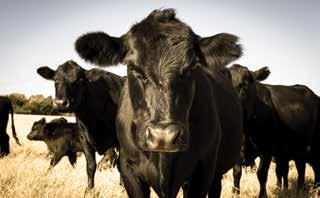
We can’t wait to see you in ‘Moo-orleans’ for #CattleCon23! Be sure to catch our Learning Lounge session on the tradeshow floor to learn more about how beef and corn work together!
To learn more about NCGA’s animal agriculture initiatives and what sustainability means to America’s corn farmers, visit us at: ncga.com
View our latest episode of Cattlemen to Cattlemen, as corn and beef producers discuss the value of exports and how trade and waterways infrastructure impact their operations!

Looking to the Future While Staying Rooted in Tradition
By Don Schiefelbein, NCBA President
It’s January, and that often means setting New Year’s resolutions, planning and looking forward to the changes ahead. I like the idea of a clean page at the beginning of the year — the endless possibilities, the goal-setting, the drive to achieve more. It provides a reason for each of us to think about the future and plan next steps.
Things I’m pondering as we head into the New Year are: What genetics best fit our operation and our customers’ needs? How can we make sure the beef eating experience is fantastic and consumer demand for our product remains strong? What new technology is on the horizon? How do we continue to make the needs of the industry apparent to those in Congress?
Yet the reality is there are still circumstances that we all face in the industry that aren’t going to change. Our lives and businesses are often a balancing act between the legacy that means so much to us and the need to keep up with advancements that support efficiency and profitability.
side ultimately lands in the center of someone’s plate, and that’s not changing. Our focus here has led to strong consumer demand for our product.

The fundamentals of farming and ranching and transparency with how we operate are things that build trust. In fact, according to NCBA’s Checkofffunded Consumer Beef Tracker, more than two-thirds of consumers surveyed have positive perceptions about beef, and 60% said farmers and ranchers are the most credible sources of information when it comes to production practices; it was veterinarians that nudged us out of the top spot. I think this is awesome
As an industry, what we do on the cattle production side ultimately lands in the center of someone’s plate, and that’s not changing. Our focus here has led to strong consumer demand for our product.
Many people associate ranching with the show Yellowstone. We’ll have an opportunity to hear from the Yellowstone creator, Taylor Sheridan, in New Orleans at the Cattle Industry Convention, and I’m looking forward to talking to him about his background in ranching and how he translates it to television. But we also know the show is a fictional portrayal of our industry. More and more Americans are becoming multiple generations removed from production agriculture. When asked where their food comes from, they simply say, “The grocery store.”
We talk about telling our story a lot but that’s because there’s still a need to share the heritage of our livelihood and our commitment to continued progress. The common theme in many of our stories is the things that are fundamental to our businesses. These fundamentals include our commitment to land and water conservation, our focus on animal welfare and the importance of producing a consistent, quality product. As an industry, what we do on the cattle production
news for us and tells me that we’re doing something right. But, we never want to get too comfortable. We can always improve. The Consumer Beef Tracker also told us where we need to keep working. Of the consumers surveyed, only 27% said they are familiar with how beef cattle are raised, but more than half said they consider this aspect when choosing protein and their chief concern is animal welfare.
Heading into the New Year we need to have tools and data that help us make good decisions to keep those fundamentals moving forward. But we can’t lose sight of the fact that we’re still dealing with a public that doesn’t understand us. This is where I think NCBA provides incredible value; we don’t have the time to shout our stories from the rooftops, but we have an entire organization behind us making that their priority.
Some things change and some things stay the same. But, regardless of what the New Year brings, I’m glad we’re in this together.
Optimism
By Colin Woodall, NCBA CEO
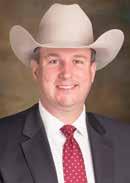

One of the best parts of my job is the opportunity to participate in meetings and conventions put on by our state partners. NCBA is most effective when we have our ear to the ground listening to members, volunteer leaders and Checkoff investors. As I participate in these meetings, I have been amazed at the amount of optimism expressed by the attendees. Simply getting back to having meetings with pre-COVID attendance numbers, or higher, speaks volumes about this optimism. I believe there is plenty to support continued optimism as we start the new year.
The plague of drought remains over many portions of the United States, and its effect on the size of our domestic herd harkens back to our experience in the last big drought. Wait! Was I not just talking about optimism? Well, meteorologists are getting bolder in their forecasts that we will see a shift from a La Niña weather pattern to an El Niño one around the middle of the year. I realize it will not come soon enough for some of you, but to know that hope, and rain, is on the horizon helps with our optimism. We are already seeing snowpacks in many of the western mountain ranges that are at, or above, their normal percentages.
Many of the challenges we face are accompanied by a silver lining. Drought-induced herd liquidation means that the supply of cattle is dramatically different from a few years ago. Demand for beef, however, remains high. The consumer is with us and wants to eat beef as illustrated by our experience in restaurants and retail grocery stores this past year. Beef prices went up, but the consumer kept buying. They kept buying because the high quality of our beef delivered an eating experience they wanted to enjoy time and again. Much of that demand is thanks to the work of the Beef Checkoff. Back in October, we utilized our role as a contractor to the Checkoff by working with Uber Eats and Sonic on a six-day cheeseburger promotion. Our work increased cheeseburger sales by 218%! When it comes to pure eating pleasure, we know we are the protein of choice, and our Checkoff-funded work keeps moving beef.
That demand is key because it is resulting in higher prices being paid for cattle. Economists and market analysts are telling us that the outlook is good for cattle prices in 2023. We need it, but
the prices we are paying for fuel and production supplies are taking the shine off these increased prices. Once again, here is a place for optimism as there are signals that inflation could start to wane this year. That will help us get more out of improved cattle prices while giving the consumer even more money in their pocket for beef.
There is also reason to be optimistic in Washington, D.C. A Congress that has split control is one we can take advantage of. We expect that a Republican House of Representatives and a Democrat Senate results in a log jam on Capitol Hill. A log jam means that only legislation with support from both parties has a chance to get through. That protects us against bad legislative ideas. NCBA has friends in both parties, so we will press forward with our policy priorities, especially in the upcoming Farm Bill. Programs such as funding for the Environmental Quality Incentives Program (EQIP), the Foot and Mouth Disease (FMD) vaccine bank and USDA risk management tools have bi-partisan support. While it might be a big lift to get the Farm Bill done before it expires in September, our priorities will see a lot of support.
Programs such as funding for the Environmental Quality Incentives Program (EQIP), the Foot and Mouth Disease (FMD) vaccine bank and USDA risk management tools have bi-partisan support.
Optimism for the year will be on full display in just a few short weeks as we gather for the 2023 Cattle Industry Convention and NCBA Trade Show in New Orleans. It is not too late to register. In fact, unlike the price of everything else these days, the registration cost to attend convention did not go up. It has been the same price for five years. This is the premier event for cattle producers where we get the chance to have some fun, learn a little, set the policy for the association and enjoy the cattle industry’s largest indoor trade show.
Each new year brings a time for optimism and fresh starts. The outlook for 2023 will only help bolster our optimism. We are fortunate to be a part of such a great and noble profession. To care for our families, our cattle and the natural resources we steward is something we all take pride in. What we do matters. Thank you for your fortitude, persistence and commitment to producing the best tasting beef in the world.
THE OFFICIAL PUBLICATION OF NCBA
2022 NCBA Leadership
President Don Schiefelbein
President-Elect Todd Wilkinson Vice President Mark Eisele Treasurer Joe Guild Federation Division Chair Brad Hastings
Federation Division Vice-Chair Clark Price Policy Division Chair Buck Wehrbein Policy Division Vice-Chair Gene Copenhaver
Immediate Past President Jerry Bohn
Chief Executive Officer Colin Woodall
Senior Editors John Robinson Jill Johnson
Editor Sarah Drown
Contributing Writers Wendy White Hunter Ihrman



For ad sales contact Summer Johnson 303-8503346, Shannon Wilson 303-850-3345, Lindsay Clark 303-850-3339, Kate Ramsey 303-850-3321 or Jason Jerome 303-850-3313.
Contact NCBA: 9110 E. Nichols Ave., Suite 300, Centennial, CO 80112 (303-694-0305); Washington D.C.: 1275 Pennsylvania Ave. N.W., Suite 801, Washington, D.C. 20004 (202-347-0228). National Cattlemen’s Beef Association reserves the right to refuse advertising in any of its publications. National Cattlemen’s Beef Association does not accept political advertising in any of its publications. National Cattlemen’s Beef Association does not accept any
advertising promoting third-party lawsuits that have not been endorsed by the board of directors.
©2023 National Cattlemen’s Beef Association. All rights reserved. The contents of this magazine may not be reproduced by any means, in whole or part, without the prior written consent of the National Cattlemen’s Beef Association.
KEEP UP WITH THE LATEST NEWS www.NCBA.org




www.NCBA.org NATIONAL CATTLEMEN 3
Grace Vehige
Creative Director Don Waite Graphic Designer Dancinee Jennings
Hear Us
Like Us. Follow Us. Watch Us.
FROM ALL OF US AT NCBA
Feeding the Rockies with Ground Beef
HOPE of the Grand Valley, a nonprofit that helps working families.
“One time I actually, went when they did the distribution to these working families at HOPE of the Grand Valley, and it was interesting to see how excited they were to get a fresh product,” Janie said. “They were used to getting boxes of mac and cheese, and here they were getting high-quality protein. That was a really moving evening for me.”
Janie has seen the charitable organizations in her community work together to support one another and uplift their neighbors. Occasionally, when she delivers meat to the local food banks, Janie sees families gathering their groceries for the week, and it reminds her how important her and her family’s role in agriculture is to feed their community.
“Janie is really at the forefront, pushing their product and presenting a positive image of a rancher and a livestock person in the community,” Baysinger said. “She’s a good example to younger people.”
What’s next for VanWinkle Ranch?
With Dean back on the ranch after graduating from Kansas State University with his wife and daughter, the next step for the VanWinkles is to figure out how the next generation will fit into the operation. Dean is active in managing and caring for the cattle beside his mother and father.
“We instituted weekly meetings where Dean and his wife sit down with us to talk about what got done last week and what we are going to do this week,” Janie added. “As they point out frequently, I am not around as much as I used to be!”
In addition, the VanWinkle family will continue to serve their community the way they know how — delivering delicious beef and advocating on behalf of farmers and ranchers.
First Generation Producer Raises His Family on the Farm

Many cattle producers know the challenge of balancing an off-the-farm job with maintaining a cow herd. Throw a husband/wife and kids into the mix and things get chaotic quickly. However, most people would tell you it is well worth the sacrifice of time.
Brandon DuBois knows this hectic lifestyle all too well. Living with his wife, Hannah, and three kids — Adisyn (12), Avery (10) and Porter (4) — in Winnifield, Louisiana, they raise purebred Brahman cattle. While Brandon didn’t grow up on a cattle farm, he got an early start into the business by showing livestock in 4-H and FFA. Right out of college, he purchased his first set of calves to start a commercial herd.
Brandon and Hannah are first-generation cattle producers, but Hannah’s greatgrandparents grew cotton and sweet potatoes on land that has been in the family since the 1800s. Brandon and Hannah have been blessed to build their home on that land.

“I am a first-generation cow guy, and it all started by buying my first calf after a rodeo calf scramble,” Brandon remembered. “My 4-H agent and FFA adviser helped me decide to pursue a career in agriculture.”
From his first two calves, he expanded a Brahman-influenced commercial cowcalf herd. As life sped up, he was working full-time for John Deere, working as an auctioneer, and raising a family, so Brandon decided it was time to scale back the herd, quit leasing pastures, and start focusing on a seedstock operation.
“Going from a commercial cow-calf to a purebred operation was a big learning curve,” Brandon said. “Now we have to keep up with the latest and greatest reproductive tools.”
The DuBois’ have been raising purebred cattle for about two years, and they enjoy the values and work ethic that raising cattle instills in their children, two of whom are involved in 4-H.
“My kids get up every morning at daylight, and they are out feeding their show animals,” Brandon said. “That’s where it starts; it starts in the barn.”
Rearing three young kids on the farm, with two working parents, can be chaotic. In between Brandon’s job at John Deere, and his own auction business, it’s also important to him and Hannah to be an involved family — watch the girls’ softball games, take the kids to gymnastics or soccer practice, and help them care for their 4-H animals (ironically sheep, not cattle).
“I tell everybody this; I showed pigs and cattle a little bit in 4-H and FFA, and we raise cattle, but they show lambs,” Brandon joked.
In the future, Brandon and Hannah will continue to fine-tune their Brahman cattle and teach their children the value of waking early, caring for livestock, and producing a well-raised animal. The lessons Adisyn, Avery and Porter learn on the farm are priceless.
“I believe whether it’s showing or just feeding calves, it’s teaching those kids that nothing comes for free. It teaches them work ethic and responsibility,” Brandon
explained.
Looking forward, Brandon is eager to transition his auctioneering business to a fulltime career. DuBois Auction Company hosts livestock sales, estate sales, liquidations and banquet auctions. Brandon has been a licensed auctioneer for 15 years. Brandon and Hannah are the owners of the company, and they recently purchased a piece of property near the Mississippi River with the goal to expand and begin selling farm equipment and real estate.
“We started out very small, like most auctioneers, selling junk. And now, we are opening a farm equipment auction,” Brandon explained.
In addition to growing the auctioneering company, Brandon has set goals for his cattle herd. Raising quality Brahman cattle to sell at seedstock auctions or to young students for show animals is his priority. Part of growing as a more well-rounded cattle producer includes being active in local, state and national cattlemen associations and actively using Best Management Practices to steward their land for future use.
Preparing the land and cattle business for his children, if they choose to carry it on, means fostering a sustainable ecosystem for generations to come. Brandon and Hannah have always implemented rotational grazing and mineral rotation to manage soil erosion.
Brandon believes the longevity of cattle farming isn’t solely dependent on caring for the land, but also fostering a healthy political atmosphere for producers and driving beef demand by consumers. Brandon was involved with Louisiana Cattlemen’s Association (LCA) immediately after college and was mentored by Robert Joyner, the serving executive, who became a close friend. Now, Brandon serves LCA as vice president.
“Being involved, being on the board, and growing with the organization showed me how LCA and NCBA help our producers,” Brandon said.
From education to natural disasters to policy, Brandon believes that organizations like NCBA and LCA, with producers collaborating on pivotal issues, will guide the cattle industry to a bright future, one where his children can raise cattle and enjoy highquality beef.
4 NATIONAL CATTLEMEN www.NCBA.org These are companies that have teamed with NCBA as corporate members, demonstrating their commitment to the beef industry. Their involvement strengthens our future. NCBA members are urged to support these partners in turn by purchasing their products and services. Those who would like to become corporate members with NCBA (securing premium booth placement at the annual convention and trade show as well as other membership benefits), please call the Corporate Relations team at 303-694-0305. Animal Health International www.animalhealthinternational.com Boehringer Ingelheim Animal Health Inc. www.bi-vetmedica.com/species/cattle.html Caterpillar www.cat.com Central Life Sciences www.centrallifesciences.com Corteva Agriscience™ www.corteva.com Elanco Animal Health www.elanco.com John Deere www.deere.com Merck Animal Health www.merck-animal-health-usa.com Micro Technologies www.microtechnologies.com Moly Manufacturing www.molymfg.com New Holland Agriculture www.newholland.com Purina Animal Nutrition LLC www.purinamills.com/cattle Ritchie Industries Inc. www.ritchiefount.com Roto-Mix www.rotomix.com Zoetis Animal Health www.zoetis.com ALLIED INDUSTRY COUNCIL CHR HANSEN Envu Farm Credit Council Huvepharma, Inc. Lallemand Animal Nutrition Neogen Norbrook, Inc. Rabo AgriFinance RAM Trucks ALLIED INDUSTRY PARTNERS 44 Farms ADM Animal Nutrition, Inc. Advanced Ag Products Agri-Pro Enterprises of Iowa, Inc. AgriWebb Alltech, Inc. American National Insurance Arrowquip A.T. Ferrell Company Inc. Bank of America Barenbrug USA Bass Pro Shops/Cabela’s Behlen Manufacturing Bimeda BioZyme Bush Hog Inc. Cargill Animal Nutrition Case IH CEAT Specialty Tires CME Group DATAMARS Livestock Dell Technologies Diamond V ENDOVAC Animal Health Farmers Business Network Fera Diagnostics & Biologicals Corp Ferrell Gas Food Safety Net Services Furst-McNess Company Gallagher Gravely, an Ariens Company Greeley Hat Works Hayden Outdoors Real Estate Hyundai Construction Equipment IMI Global International Stock Food International Genetic Solutions IVS Jorgensen Land and Cattle Kent Nutrition Group Kubota Tractor Corporation Kunafin “The Insectary” Laird Manufacturing Meat & Livestock Australia, Ltd. Micronutrients National Corn Growers Association Nationwide New Generation Supplements Noble Research Institute PBS Animal Health Phibro Animal Health Pneu-Dart Priefert Ranch Equipment QualiTech, Inc Quality Liquid Feeds Ranchbot Red Angus Assoc. of America R&R Machine Works RFD-TV Roper/Stetson/Tin Haul Apparel and Footwear South Dakota State University Stone Manufacturing Superior Livestock Supreme International Syngenta Tarter Farm and Ranch Equipment The Hartford Livestock Insurance The Vit-E-Men Co. Inc./Life Products Trans Ova Genetics U.S. Premium Beef Vaxxinova wVermeer Vitalix Vytelle Westway Feeds Wild River Y-Tex Zinpro Performance Minerals GOLD LEVEL SPONSORS (Minimum $100,000 Investment)
COUNCIL American Foods Group Cargill Meat Solutions Certified Angus Beef Darden Restaurants empirical Fareway Stores,
Five Guys McDonald’s
National Beef
Omaha Steaks Preferred Beef Group Tyson Fresh
PRODUCT
Inc.
Corporation
Packing
Meats
CORPORATE MEMBERSHIP DIRECTORY
Continued
from page 1
The VanWinkles load the truck full of cattle they have gathered in the Colorado mountains.
CUT. RAKE. BALE. REPEAT.™
From first cut to last bale, New Holland hay and forage equipment helps you make top-quality hay and make it more productively—day in and day out. That’s the advantage of our over 125 years of invention and innovation. New Holland haytools save you time and money, all while maximizing quality and feed value. You’ll also work more confidently, knowing your local New Holland dealer is there with unparalleled service and support when it matters most. Cut, rake, bale, repeat—no one does hay better.



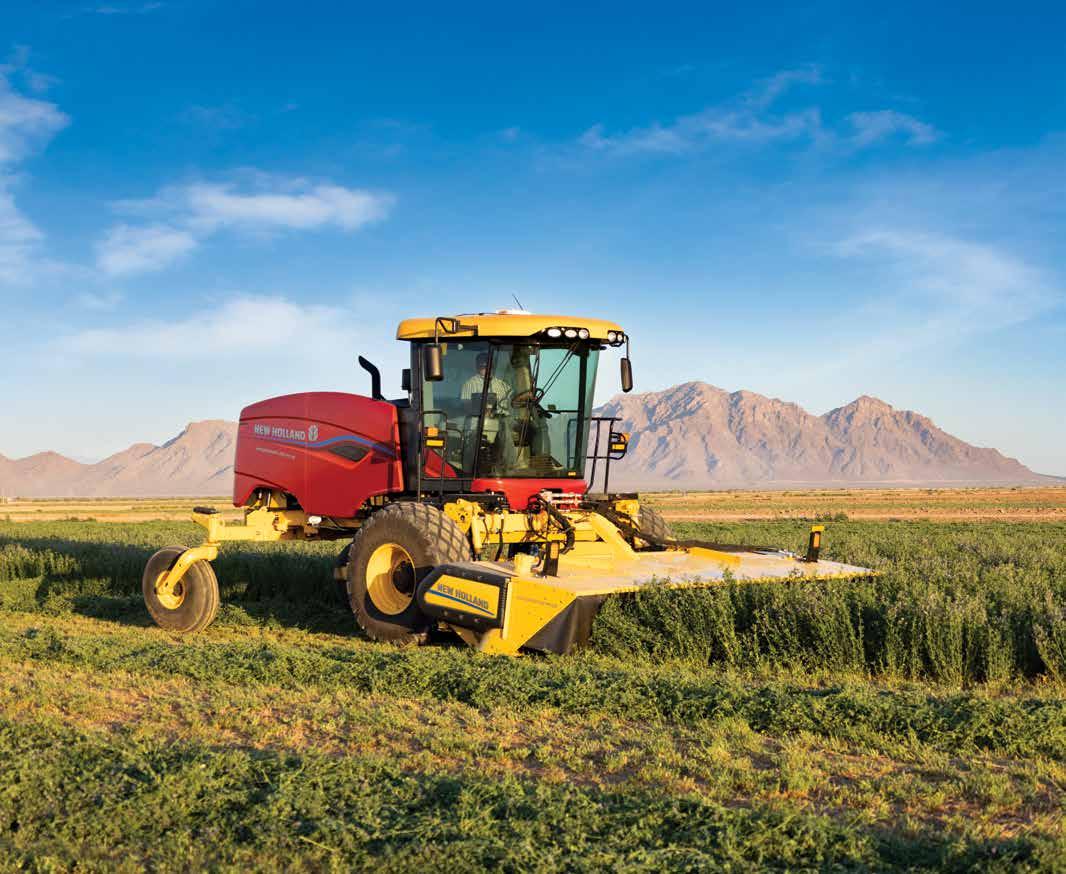
©2022 CNH Industrial America LLC. All rights reserved. New Holland is a trademark registered in the United States and many other countries, owned by or licensed to CNH Industrial N.V., its subsidiaries or affiliates. newholland.com
NCBA Members qualify for exclusive savings on New Holland Equipment.
Feeding Cows with Limited Forage
By David Lalman
Oklahoma State University Professor
Cow-calf operations in many parts of the country face the reality of inadequate standing or harvested forage availability this winter. Many have marketed cows to better match feed requirements with forage inventory. What can be done to stretch the forage supply and (or) winter a few more cows?
For operations relying on harvested forage, be sure the feeding management program is designed to minimize waste. One strategy is to roll or flake a limited amount of hay out daily. The idea is to feed just enough to ensure the hay is “cleaned up” every day. Of course, the added benefit of distributing hay in this manner is better distribution of manure and waste organic matter throughout the pasture. Come to think of it, this is how I learned to drive. Standing in the seat “driving” while my dad fed little square bales from the back of the pickup truck. I did not know we were on the cutting edge back then, but I do know we did not waste hay.
In situations where large round bales are fed in “rings” or feeders, consider using a design that minimizes waste. Land-grant institutions have documented drastic differences in hay waste related to feeder design. Inexpensive, lightweight, open-design feeders have their advantages, but can waste up to 21% of the original bale weight. In contrast, we have studied feeders that limit waste to as little as 5% of the original bale weight. Important features include a solid-sheeted bottom (18 inches or so), some type of a cone or basket mechanism, and either a solid-sheeted top or narrowly spaced bars to minimize access to the top half of the bale. These features limit hay being pulled off the bale and dropped directly onto the pen or pasture surface. Secondly, they create feeding space on the inside, resulting in loose hay being dropped back inside the feeder for later consumption.
Concentrate feeds can be used to replace nutrients that would normally be provided by forage. This approach requires more labor and more intense management. A cow can get by with as little as about 0.4-0.5% of her body weight in roughage or forage given the bulk of energy, protein, vitamin and mineral needs are provided in a concentrate feed mix. The roughage portion is intended to keep the rumen healthy and minimize the risk of bloat and founder. The lower the level of roughage fed, the more intense management required to avoid digestive upset issues.
An example of a limit-fed diet for 1,200-pound gestating cows is provided in Figure 1. This diet consists of one-third grass hay, one-third dried distiller’s grain, one-third rolled corn and a vitamin/mineral premix. This diet is energy and protein dense, so the cattle do not need free-choice access. In this example, the feeding rate is limited to 15 pounds per head per day (as-fed basis). This is only about half of the amount of dry matter these cows would normally consume. Nevertheless, you can see that the cows are projected to gain about 0.6 pounds per day. Hay, rolled corn, and dried distiller’s grain is priced at $125, $290, and $355 per ton, respectively. The resulting projected daily feed cost is $1.96 per cow. Nonfeed costs, such as equipment, yardage and labor would need to be added to the feed cost.

Genetic Testing for Horses
From the American Quarter Horse Association
Screening for genetic defects can help improve the overall health of your horse herd. The American Quarter Horse Association recommends that owners screen Quarter Horses for six genetic defects, and testing can be simplified through a panel test.

When a test is ordered through AQHA, the owner receives the kit, then mails a hair sample directly to the Veterinary Genetics Laboratory at the University of California-Davis. AQHA notifies the owners and adds the results to the horse’s record and certificate of registration. The genetic panel test costs $100 for AQHA members and $155 for nonmembers.
The effects of these genetic diseases are wide-ranging, from mild and manageable to severe and terminal. Read on to learn about the six diseases covered in the AQHA panel test.
GBED: Glycogen Branching Enzyme Deficiency Disorder
GBED is a fatal disease where affected animals may be aborted or stillborn. Foals that survive to term typically die or cannot stand or nurse on their own. Foals may appear healthy for a time but eventually may develop seizures, become too weak to stand, or in some cases, die suddenly.
GBED affected horses lack an enzyme that is used to properly make the necessary sugars muscles need to function and cannot store the sugar needed for
Cattle should be gradually transitioned from a free-choice (all they can eat), high-forage diet to a concentrate-based diet like the one shown in Figure 1. Feed must be delivered every day, and ideally, at the same time every day. Cows must have adequate linear bunk space; at least 30 inches per cow. Also, to make this strategy work, the cattle should be confined to a pen or pasture with little grazeable forage.
Hay can be coarsely chopped and blended in the diet, although added moisture will be required. In the example diet, dry ingredients are used, assuming these ingredients would be more accessible to a larger percentage of cow-calf operations. Obviously, wet ingredients such as silage, wet corn gluten feed, or wet distiller’s grains are ideal for these limit-feeding programs. Blended dry diets like the example provided are subject to sorting by the cattle, which can lead to inconsistent performance and potentially bloat. Molasses-based liquid feeds are a
numerous tissues in the body. This means the tissues are energy impaired, resulting in muscle weakness and organ failure.
HERDA: Hereditary Equine Regional Dermal Asthenia Disorder
HERDA is a skin condition that is characterized by hyperextensible (more elastic than normal) skin, severe scarring, and open and slow-healing wounds along the back of affected horses. HERDA causes collagen between skin layers to not form properly, resulting in a horse that is easily injured.
HYPP: Hyperkalemic Periodic Paralysis Disorder
HYPP is characterized by sporadic attacks of muscle tremors (shaking and trembling), weakness, and/or collapse. Attacks can also be accompanied by loud breathing noises resulting from paralysis of the muscles of the upper airway. This genetic mutation disrupts the muscle’s sodium channel resulting in too much potassium in the blood. This causes severe muscle cramping, pain, and in extreme cases, paralysis resulting in death.
MH:
Malignant Hyperthermia Disorder
MH is a genetic mutation that causes a life-threatening condition triggered by certain anesthesia drugs such a halothane or isoflurane. MH can also be triggered by stress or excitement. During an episode, a horse with MH will release uncontrolled amounts of calcium into the bloodstream, which results in painful muscle cramps, extremely high temperature up to 113 degrees Fahrenheit, irregular heart rhythm, excessive sweating and shallow breathing. A horse that has PSSM or MYHM in conjunction with MH will likely have much more severe episodes.
PSSM: Polysaccharide Storage Myopathy Disorder
PSSM is a disease that causes an abnormal accumulation of glycogen, the form of sugar stored in the muscle. This excess sugar causes mild to severe muscle cramps, sore muscles and/or muscle weakness. Horses that are managed properly can generally go on to have successful performance careers. Two types of PSSM have been classified: PSSM1 and PSSM2. The genetic test used by AQHA identifies PSSM1 mutation.
MYHM: Myosin-Heavy Chain Myopathy
MYHM is a relatively new discovered genetic disorder, which can result in two distinct clinical disease presentations that both involve muscle loss or damage and are linked to the same genetic variant. A horse with MYHM is prone to presenting with one or both during their lifetime, while some horses with the mutation may never experience symptoms. Immune-Mediated Myositis (IMM) is one form of clinical disease caused by MYHM, resulting in muscle atrophy often as the result of a response to a vaccine or infectious agent such as strangles. The immune system misinterprets the muscle cells as foreign and rapidly attacks them. Horses initially experience stiffness, weakness and a decreased appetite followed by the rapid loss of 40% of muscle mass within 72 hours. The second presentation of MYHM is Nonexertional Rhabdomyolysis and often presents as stiffness, like “tying up,” and possible swelling of muscles along the back and haunches without exercise.
AQHA
Genetic Health: New Online Resource
AQHA now offers an interactive tool at www.aqha.com/genetics that educates owners and breeders about how genetic diseases affect an American Quarter Horse. The online resource provides information about special care a horse might require and prompts thoughtful breeding decisions.
6 NATIONAL CATTLEMEN www.NCBA.org
Figure 1. Limit-fed diet for gestating cows.
great way to condition the ration, reduce sorting, and serve as a carrier for the vitamins, minerals and feed additives. Alternatively, we have had great success mixing the diet, then just before feeding, blending in 25%35% water by weight.
An alternative that works especially well for smaller operations is to feed the hay portion and the concentrate portion separately. One simple strategy that has worked well is to place an adequate number of hay feeders (adequate to provide a feeding space for every cow) in a pen or small grass trap. Open the gate to let the cows in to the grass hay. After 45 minutes, cows should consume about 0.5% of their body weight in hay. More time in the hay pen results in more hay intake. Therefore, the composition of the diet can be manipulated by adjusting hay access time. For example, an hour in the hay pen should increase hay intake and lower risk associated with some cows getting too much grain and too little roughage.
The concentrate blend can be fed in bunks outside of the pen while the cows are consuming hay. Producers using this technique have discovered that the cows learn the program rapidly. As you can imagine, the cows do not require encouragement to move into the hay pen because they will be hungry at feeding time. Nor will they hesitate to move out of the pen once the gate is opened allowing access to the concentrate feed.
The most cost-effective feed commodities will vary widely throughout the country. Balancing the diet to provide adequate energy, protein, vitamins and minerals while restricting intake can be complicated. Several nutrition evaluation programs are available to simplify this task. These models can help determine which feeds are the most cost effective and how much of each should be provided. Commercial and university-sponsored programs are available. These models are generally based on the National Academy of Sciences publication, “Nutrient Requirements of Beef Cattle, Eighth Revised Edition” which is 475 pages! A few of the university-sponsored programs include:
Benefits of Grazing Cover Crops
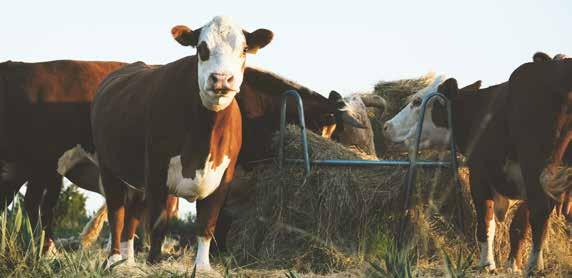
When utilized properly, cover crops have the potential to provide a variety of benefits to both cattle producers and row crop farmers. For those operations that employ both sectors, cover crops can be the missing link that brings the business full circle — with economic payoffs, animal health advantages, environmental rewards and more.
Of course, cover crops are not applicable to every operation, especially in consideration of differences in climate and business management. However, for those who do have the means and accessibility, cover crops can be a highly beneficial tool for both land and livestock. Stoney Creek Farm in Redwood Falls, Minnesota, demonstrates this well.
Grant and Dawn Breitkreutz, along with their daughter and son-in-law, operate Stoney Creek Farm, which is a family business that profits on cattle and crops alike. The Breitkreutzs run a 120-head cow-calf operation. Typically, calves are kept and run as yearlings, with the inclusion of custom yearlings that are acquired and brought in to run through the summer months.
In terms of crop production, Stoney Creek Farm grows a diverse selection — corn, soybeans, small grains, mixed grains, field peas and forages for livestock.
It is the Breitkreutzs’ commitment to conservation practices that increase production and improve soil health that led to their recognition as a 2016 regional honoree for the Environmental Stewardship Award Program (ESAP). For these same reasons, Stoney Creek Farm is a key example of how cover crops can be successfully utilized in a grazing plan.
Getting Started with Cover Crops
According to Grant, Stoney Creek Farm began grazing cover crops when the operation did not have as many acres to graze as they do today.
“We were trying to grow three crops in two years to get enough forage for the cattle. So, we would chop corn silage and then put in cereal rye or the like, and all the sudden, we noticed the benefits to the soil — what was happening and how things were changing,” Grant said.
The cover crops used for their cattle operation are seeded after the small grains or the edible field peas are harvested, which according to Grant is typically in July or August in Minnesota. This planting and grazing process is employed so that more crop growth is supported, ultimately leading to more useable feed for the cattle.
“We put a tremendous amount of diversity in our cover crop mixes,” Grant said. “We put anywhere between 15 and 20 species in there. This does what we want for the soil, and obviously, they are all edible for the cattle that graze them.”
While utilized as a high-quality forage to extend the grazing season, Grant shared that the cover crops also serve another role at Stoney Creek Farm.
“The big benefits we see on the row crops side of our operation is the reduced inputs the next year to grow corn. We are running 20-40% of the inputs that we used to grow corn, following cover crops that are grazed by cattle,” Grant said.
Impact on the Herd
Because of the notable changes to the soil that cover crops influence, Stoney Creek Farm now works to get cover crops on every single acre that is also in row
Iowa State University: BRaNDS at extension.iastate.edu
University of Georgia: Basic Balancer at extension.uga.edu




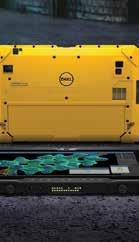

Oklahoma State University: Cowculator at extension.okstate.edu
These are powerful decision-making tools. They allow the user to combine information about the nutrient content of forage and concentrate feeds with specific conditions, class of animal, level of desired performance, body condition, mature weight, breed, etc. Additional details related to this management strategy are provided in OSU Extension Fact Sheet AFS-3028. Be sure to seek guidance from a beef cattle nutrition expert if you need assistance with diet formulation or if you have additional questions.
crop production. This year, only 10% of the Breitkreutz’s land lacks a cover crop.
This type of access to cover crops influences the family’s grazing management plan. Often, the Breitkruetz’s herd grazes cereal rye fields that are not going to be harvested. This allows for the herd to graze weeks earlier than normal before turning out to native grass pastures.
“Grazing cover crops works great here for us in Minnesota because those cows are gaining weight going into winter,” Grant shared. “Nothing is better than having a fat cow going into the winter-feeding season.”
While Mother Nature still presents her share of challenges, especially in a dry year, Stoney Creek Farm’s grazing management plan remains very flexible. Right now, however, the Breitkreutz’s herd is grazing cover crops, which as Grant said, allows for extra weight on their yearling cattle and gets the rest of the herd in good condition for winter.
David Lalman, Ph.D., professor and Extension Beef Cattle specialist at Oklahoma State University, echoed this concept.
“Probably the most beneficial thing for the cattle is the extension of grazing season and improved forage quality, depending on the time of the year and if it’s a summer or winter cover crop,” Lalman explained. “Grazing cover crops extends that grazing season and the length of time that you don’t have to provide a supplement or as much supplemental feed to the cattle.”
According to Grant, the extended time spent grazing on cover crops has positively impacted Stoney Creek Farm’s herd health as well.
“It’s just another benefit that you can’t really put on paper, but when we start looking back at history and all the cattle we used to treat in the fall of the year, usually for respiratory problems, we just don’t have those problems anymore because those cattle are in such good condition,” Grant explained.
Sharing a similar sentiment, Lalman said anytime you spread cattle out in inclement weather on pasture, they are less likely to get a disease.
“Good nutrition is always highly related to strong immunity,” Lalman shared.

Additional Benefits

Unfortunately, Stoney Creek Farm has been faced with extreme drought conditions in recent years, like many producers across the country. Due to these circumstances, cover crops have played a lighter role in the Breitkreutz’s grazing plan than usual, but that does not mean the forages stop providing benefits.
“Even for a dry year, those cover crops are a huge benefit for the soil. It is about having a living root in that soil all the time,” Grant said. “It keeps the soil health there and feeds the biology in the soil.”
For a producer looking to graze cover crops, Grant said it is worth the try. The Breitkreutzs have found a few key payoffs — lessened weed pressure in crop fields and lessened inputs to grow the same bushels next year.
Take it from Grant, “There are so many benefits to cover crops when you start studying it.”
www.NCBA.org NATIONAL CATTLEMEN 7
matter where your work takes you, Dell Technologies is here with seamless solutions to keep your productivity at its peak.
can access these solutions at additional savings up to 10% off.
or use the QR Code to access
savings. Members save an extra 5-10% off
SCAN
ME No
NCBA members
Visit ncba.org/delltechnologies.aspx
these
By Matt Makens Atmospheric Scientist

La Niña has been a driving force behind our weather patterns for the past couple of years, yet it began to show weakness in November and early December. For November, La Niña was the weakest it had been in more than two years. That is based on the atmosphere-related measurement called the Southern Oscillation Index (SOI) for monthly values since 1950.
That measurement shows how closely the atmosphere works in tandem with the sea surface conditions in the El Niño Southern Oscillation (ENSO) region where we look for La Niña and El Niño. Ignoring the atmosphere and looking at the ocean, that ENSO region remains firmly in a La Niña with only one small section becoming more neutral throughout November into early December. Most of that ENSO region was La Niña through early December.
November is commonly a month when we see the atmosphere wanting to behave a bit more chaotically and break away from certain connections it has with the oceans. This is because the weather is adjusting from a summer pattern to a winter one, which comes down to how the whole system moves energy around is different between hot and cold seasons. At some point in the winter, the atmosphere will adjust to its new pattern and reconnect with certain ocean conditions, including the ENSO region. When our atmosphere does this, it will act as La Niña until the sea surface temperatures change and dictate otherwise.
The ocean transition is happening now and will continue throughout 2023. Projections through spring continue to diminish La Niña in sea surface conditions, allowing a neutral ocean pattern to establish itself. For March, April and May, the statistical probability of a neutral pattern climbs to more than 70% likelihood, thus ending La Niña’s dominance if projections are accurate. Once the transition is in full swing, we open the door for El Niño. I do not believe El Niño will come charging through, but it will gradually enter the picture later in 2023 through 2024.
What might this look like? If you recall, 2012-2015 was a drawn-out period of watching El Niño establish itself and grow stronger. That is a lengthy process, and it took a long time for our weather patterns to settle in on an El Niño regime. We sat in neutral territory for quite a while during those years; 2012 and 2013 bounced around between moments of La Niña and El Niño before we recorded a more substantial El Niño presence in 2014, peaking in 2015.
At this point, there simply is no way of knowing if this historical example of a very long process will repeat itself or if we can more traditionally skip ahead to El Niño within a few months. If we skip ahead quickly, most of us realize what El Niño does to our operations during winter, which is certainly possible for next winter. As this article is titled, I want to look at the 2012-2015 period as an example of how a more drawn-out transition will look.
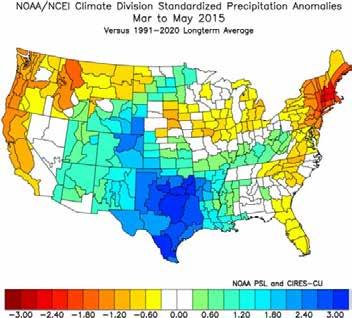
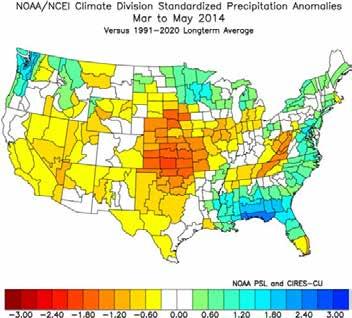
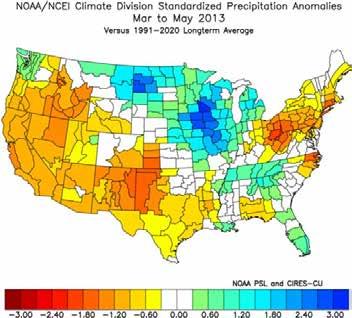
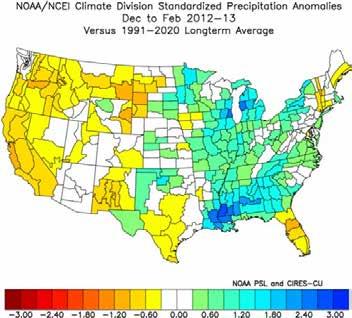


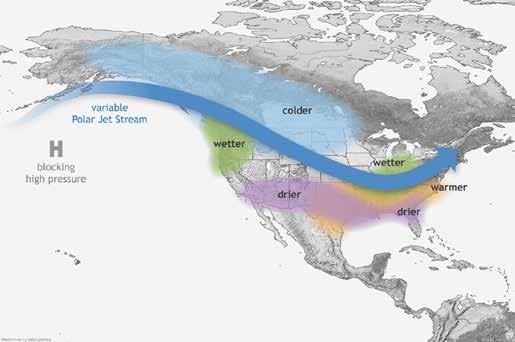

8 NATIONAL CATTLEMEN www.NCBA.org
What a Transition Away From La Niña Could Look Like Photos courtesy of https://psl.noaa.gov/enso/. DECEMBER TO FEBRUARY 2012 2013 2013 2014 2014 2015 MARCH TO MAY 2013 2014 2015 NOAA/NCEI Climate Division Standardized Precipitation Anomalies Versus 1991−2020 Longterm Average
The composite image is created by looking at the precipitation anomalies from 2012 through 2015, broken into winter and spring, displayed left to right. As your eye traces the images from 2012-2015, you may begin to see how the abnormally dry conditions from early maps diminish as areas with surplus moisture become more frequent later in the time series. This change is especially true for the central and southern U.S. I will direct your attention to the northern U.S., especially the Pacific Northwest, where dry anomalies become more frequent throughout time, which is not coincidental. Let’s compare a generalized weather pattern between El Niño and La Niña to see how different the two are.


The transition from one phase to another is critical with differences like this in our weather pattern. I showed you an example of a very long-term transition between two phases. If that is cut much shorter, we will still see dry areas of the central U.S. become less so and wetness increase across the South as the Northwest and other parts of the northern U.S. begin to dry out. The transition is similar, whether lengthy or brief — and, at this moment, there is little data to support one over the other.
The answer to this question will begin to have some evidence as we get into the spring months and, indeed, the summer. We will watch the oceans and the atmosphere to see the tendencies, but other clues will emerge during that time.

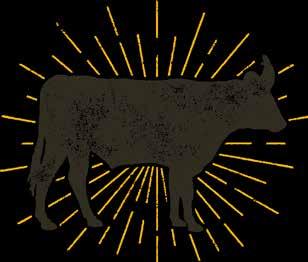
Observational connections can be made between several places on Earth and



the future of El Niño. For example, it has long been noted that the moisture received, or lack thereof, in parts of Brazil during March can indicate El Niño by the following winter. There is an observed connection between the upper atmosphere near New Zealand in spring, combined with sea surface conditions, and the moisture tendencies over the Southwest U.S. the following winter. Those are just a couple of examples, with several others available to combine with our historical knowledge and computer simulations to monitor the ultimate growth of El Niño as/if it develops.
For the sake of argument, hypothetically, when do we feel and see changes if we have a speedy transition and see signs of El Niño already appearing by summer? For the summer, you can see the differences in daily high temperatures and precipitation coverage between the phases of La Niña, which we have had the past two summers, and El Niño. The image is not intended as a forecast; this is a historical perspective on what has happened based on ENSO strengths.A plausible transition to a weak El Niño by summer would be quite a change from what we have had the past couple of years. The temperatures will be much cooler, and precipitation will be much more widespread. Again, that is if we have a rapid transition. As discussed, that remains to be seen, and I will have updates for you on this speed of change right here in the National Cattlemen or weekly on airings of Cattlemen to Cattlemen
www.NCBA.org NATIONAL CATTLEMEN 9
www.AgRiskAdvisors.com Sunup to sundown, we work tirelessly for you, even before you have a policy Our advisors can use our propriety tools including daily interval reports, weekly weather updates and daily Livestock Risk Protection rate emails. Don’t get stuck with just an agent, hire an Advisor! www.AgRiskAdvisors.com (303) 539-9300 (303) 539-9300 1. Journal of Applied Meteorology and Climatology 58, 6; 10.1175/JAMC-D-18-0252.1 April 25-27, 2023 T ent a ti v e J W MA RRI OT T WASHINGTON D.C. S A VE T H E D A T E www.NCBA.org
Region V Report — In the Rearview Mirror
In this region report for Region V, consisting of Oregon, Washington, Idaho, Montana, Colorado and Wyoming, we will examine the various events, litigations, new executives, and challenges of these states.
At the Region V summer meeting in Reno, Nevada, last July, the group thoroughly discussed the federal acquisition of private property. More specifically, the BLM purchase of the Marton Ranch in Wyoming using dollars from the permanently funded Land and Water Conservation Fund. With the Biden administration’s “30 by 30” agenda, this is a trend that we may see more of in the future. NCBA’s policy book, developed annually by its membership, promotes resolutions that clearly define no net gain of acres going into federal ownership, no net loss of Animal Unit Months and other resolutions. However, the administration is taking a very different approach. We are continuing to monitor and explore additional steps that we can take to help with this trend and situation.
Another incident of federal overreach in Region V is the Montana BLM allowing the conversion of viable livestock permits into year-round grazing allotments for bison and the infrastructure to accommodate it. The rules that permittees must abide by are not being interpreted and enforced to the American Prairie Reserve and their goals of a bison refuge. An appeal has been filed to challenge the BLM’s decisions on this issue, so we await the results. It is imperative that the rules to abide by should be applied equally to all those who have a federal permit.
Recreation and its impact on grazing is impacting Region V. Modern outdoor enthusiasts increasingly have more 4-wheelers, side by sides, OHVs, RV camp trailers, trailer houses, etc. to enjoy the “great outdoor experience.” There has been some success in forming coalitions so multiple use can continue, but recreation is expanding at an accelerated pace. It looks like there will have to be more guidance and control brought forward to avoid unrestricted use of federal lands.
The region has several new executive directors who have recently come on board. Raylee Honeycutt has been named by the Montana Stockgrowers Association to take over for long-time serving Jay Bodner. Erin Karney was chosen by the Colorado Cattlemen’s Association to be executive vice president and be the first woman to lead CCA. She follows longtime stalwart Terry Fankhauser who is retiring and moving back to his family ranch. The Washington Cattlemen’s Association announced last summer that Chelsea Hajny will lead that group going forward. One of the great strengths of Region V is its strong class of executive directors.
Last summer, Wyoming celebrated their 150th year of the Wyoming Stockgrowers Association. They were successful in meeting their 150th campaign goal of raising $1.5 million for their endowment. In August, the annual meeting of the Public Land Council was held in Cody. Wyoming’s governor attended both events and even led a tour of the Capitol building. He is a governor who recognizes that agriculture is a leading, essential industry of this nation.
In Oregon, the legislation to add thousands of miles of rivers and streams into the Wild and Scenic Rivers Act was pulled at the last minute due to lack of support. A strong effort to oppose this misguided legislation was formed including Oregon Cattlemen’s Association (OCA), NCBA and the Public Lands Council. OCA is currently preparing for the long state legislative session that will include wolf compensation and water management at the top of the list of priorities. With the Republican takeover of the U.S. House of Representatives, Oregon Congressman and long-time friend of the livestock industry Cliff Bentz may be tapped to chair the Water, Ocean and Wildlife committee.
Region V scored a few litigation wins. Western Resource Legal Center was able to secure some positive court rulings involving Sage Grouse, Bighorn Sheep and a
Freedom of Information Act request involving the National Environmental Policy Act and the Endangered Species Act. Caroline Lobdell, the executive director of WRLC, continues to be a huge resource for our industry on not only dealing with legal issues but by educating young resource attorneys on current issues we face as ranchers.
NCBA has a task force working on Foot and Mouth Disease in the U.S. and the BLM and Forest Service response to animal movements on public lands. If a single case is diagnosed anywhere in the U.S., all livestock movement stops for 72 hours. It will be up to the individual states’ animal health officers to enforce this ban on livestock movements.
We hope all these “code red plans and books” being developed never have to be used. But if they ever did, animal traceability will be important. If you happen to be put in a surveillance area because of a suspect case, you will need to be able to account for the whereabouts of your animals. The quicker you can provide some kind of records or data, the quicker you can get released and back to doing business. Source verification, ranch of origin, Premises Identification numbers, EID tags and biosecurity plans are all tools that will help producers manage through this and continue doing business.
Currently the U.S. Forest Service is undertaking an exercise in developing a program called Range Futuring. This is an opportunity for our industry to participate in helping direct the Forest Service to address some of the concerns that we routinely deal with. A couple of examples would be wildfires, drought, invasive species, NEPA and, of course, funding. Grazing is a tool that can help manage some of these concerns. Public Lands Council and NCBA both have a seat on this working group and will be keeping you updated as discussions progress. Our goal is to try and promote the attitude that grazing is not the “stepchild” but the “golden child.”
From the October executive committee meeting, we learned that a recent poll of capitol hill staffers voted NCBA as the most effective lobbying body in D.C. That seems like a monumental accomplishment. It tells us we have the best people advocating on our behalf.
To end on a positive note, it is exciting to be going back to New Orleans for the 2023 Annual Cattle Industry Convention and NCBA Trade Show. Be sure to check out the WWII museum there. It is well done, and you can feel the sacrifice our veterans made for our country and our freedom. If you like history, especially WWII history, this museum is a must-see. See you in New Orleans!
Lesser Prairie Chicken Listing Disappointing for Producers
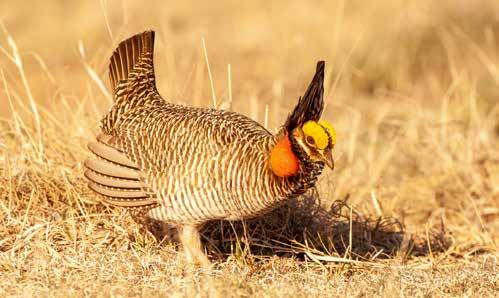
At the end of November, the U.S. Fish and Wildlife Service (FWS) announced a final rule that creates two Distinct Population Segments (DPS) of the lesser prairie chicken (LPC) and lists them under the Endangered Species Act (ESA). The Southern DPS covers portions of New Mexico and the southwest Texas panhandle, while the Northern DPS covers southeastern Colorado, Kansas, Oklahoma and the northeast Texas panhandle. The Southern DPS will be listed as endangered, and the Northern DPS will be listed as threatened.
“The science has proven that healthy, diverse rangelands — the exact kind of landscape maintained by livestock grazing — are where the lesser prairie chicken thrives. Cattle ranchers’ efforts to conserve these acres are absolutely critical to the survival of the species,” said Executive Director of the Public Lands Council (PLC) and National Cattlemen’s Beef Association (NCBA) Natural Resources Kaitlynn Glover following the decision. “We are deeply disappointed by the Fish and Wildlife Service’s decision to impose redundant bureaucracy and punitive restrictions on the very same people that we have to thank for the lesser prairie chicken’s continued existence on the range.”
The lesser prairie chicken tends to prefer habitat that is heterogeneous, with a lot of biodiversity and plant variety, as opposed to uniform cropland or cleared areas. That diverse rangeland is exactly the kind of ecosystem that is conserved and encouraged by cattle grazing.
“If the federal government is serious about protecting the lesser prairie chicken, they should make grazing easier, not harder,” said PLC and NCBA Federal Lands Associate Director Sigrid Johannes.
Concerningly, the final rule from FWS also establishes a 4(d) rule for the Northern DPS that enables the agency to appoint third parties as grazing authorities in the lesser prairie chicken’s range. Typically, cattle producers welcome a 4(d) rule because it provides legal protections for the accidental “take” of a protected species while managing the land. This rule is different, however, because 4(d) protections will only extend to producers who are following a grazing management plan that has been approved by a FWS-approved third party. The provision to appoint third parties opens the door to environmental activist groups having a say over cattle producer’s grazing practices.
“We strongly believe that the agency should listen to the true grazing experts — cattle producers,” Johannes said. “The Fish and Wildlife Service has made it clear that the agency wants true third parties to review grazing management plans, but we could easily end up in a situation where an activist group that wants to get grazers off the land suddenly has power over cattle producers and their grazing practices. FWS has yet to give a definitive answer on whether other government entities involved in conservation, such as NRCS or the BLM, will qualify as third parties under this rule.
As the clock ran out on 2022, the administration moved to list a number of
species under the ESA, and NCBA has engaged repeatedly to either prevent listings or improve 4(d) rules where appropriate.
“Very few species ever make it off of the ESA list and by contrast, when looking at state-managed wildlife populations, or even at the local level, there really are successful track records of conservation at this local level and that’s been the case with the LPC in particular,” Johannes said. “We’ve seen over recent years, with the lesser prairie chicken and with other prairie grouse species, ranchers have really led the way on conserving that habitat.”
Moving forward, NCBA is urging the FWS to be more cautious in listing species and to follow the guidance of cattle producers who have on-the-ground experience in land management.
“On the one hand, we would like to see FWS really act with a huge degree of caution and restraint when listing species in the first place,” Johannes said. “We’ve seen a lot of success when it comes to conservation of the LPC habitat at the local, state and voluntary level and as long as it’s working, we would like to see this continue.”
NCBA would also like to see cattle producers recognized for the good conservation work they are already doing that supports habitat for species like the lesser prairie chicken.
10 NATIONAL CATTLEMEN www.NCBA.org
V
MORE CHOICES. MORE CONFIDENCE.
From options like a new premium cab with more comfort and controls at your fingertips to a true 3rd-function mid-valve for easier loader installation and operation, the new 5E Series gives you more choices than ever. That includes choices that better connect you to your tractor, helping you plan for maintenance and even order parts from your mobile device. The new 5E 3-Cylinder tractor also features no regen, helping to simplify maintenance, bringing peace of mind to the ownership experience. It all leads to more confidence with every job.
TALK TO YOUR JOHN DEERE DEALER OR VISIT JOHNDEERE.COM/5E TO LEARN MORE.
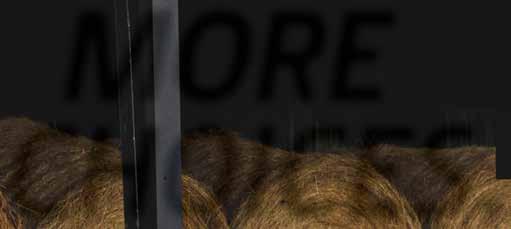


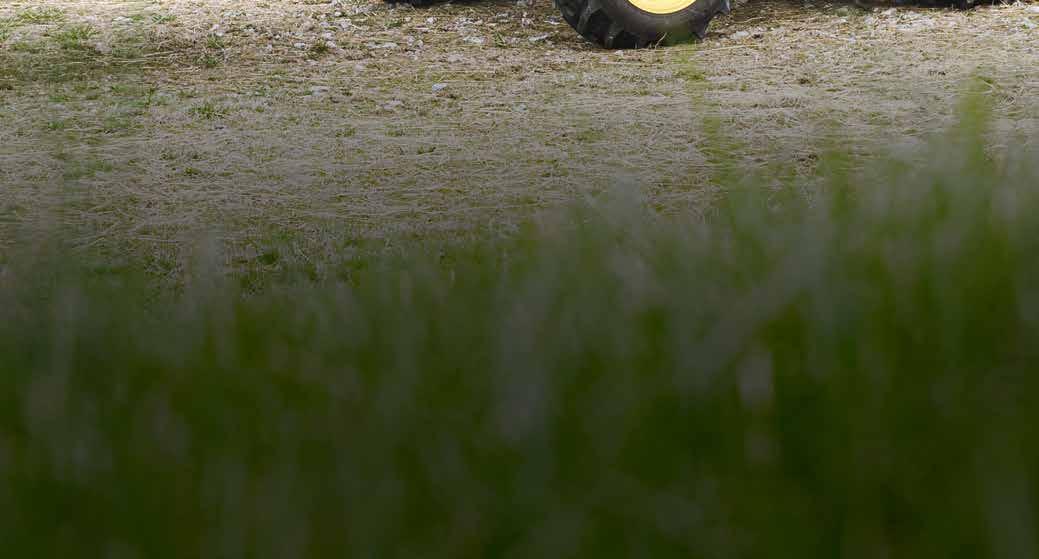


81753-15_10.38x16.indd 1 8/31/22 5:19 AM
Trim Supplies Not Expected to Be as Short as 2013/2014
By Katelyn McCullock Director of Livestock Marketing Information Center
The availability of trim supplies depends on a multitude of factors, but can be calculated using the carcass weight values, an assigned carcass percentage, and the expected number of head to be slaughtered across all classes of cattle. In addition, the U.S. imports a large degree of trim from certain countries which the LMIC has assigned a percentage of trim. These factors add up to an availability calculation that, over the last two lows in the cattle cycle, amounted to significant declines in the availability.
In 2011, 2012, 2013 and 2014, the total availability of trim fell below 8 billion pounds and hit a low of 25 pounds per person. For perspective, prior to 2007 per capita availability was above 28 pounds per person and the last bottom in the cattle cycle has not recovered significantly despite the total pounds of availability growing to more than 9 billion pounds.
LMIC has forecasted estimated slaughter and import levels for 2022, 2023 and 2024. Those declines are expected to be large in the next several years. Combined fed slaughter is expected to decline about 4-6% the next two years while cow slaughter will see larger drops of 6% and 15% in 2023 and 2024, respectively. This is in line with similar declines seen during the last cattle cycle down turn. LMIC uses a fixed-trim value by class, but things may shift as other cuts could be
ground more or less depending on market conditions.
Forecasted imports are quite large. LMIC is projecting them to reach more than 4 billion pounds in total by 2024, and a large proportion of that is assumed to be trim related products. Counter to the last cattle cycle downturn, imports have been running very high for the last several years. This has helped grow available trim supply. The percent increase forecasted in 2023 and 2024 are slightly smaller than the increases seen in 2014 and 2015 on a percentage basis. LMIC is forecasting total imports to increase 8% next year and 15% the following year. Drought in Australia and New Zealand played a significant role in 2013 limiting supplies heading to the U.S. from these regions. Imports from both those countries have been doing very well in recent years, and the U.S. is receiving more product from Brazil than it was eight years ago. These should help support available supplies in the U.S. and high U.S. meat prices are expected to incentivize supplies from other countries to come to the U.S. However, there is the question if there are enough available supplies in the rest of the world to hit the forecasted marks. Those expectations will be adjusted as needed.
The expectation for availability of all trim for the next two years is to see about a 2% decline, which would still rank high among historical values. Changes to import levels or different slaughter decline outcomes could potentially change this outlook dramatically.
Additionally, the nuance in the meat market between fed trim products versus non-fed trim is important and this analysis does not specifically cover these differences. The expectation is that non-fed trim products will be substantially tighter given the sharper contraction in cow slaughter versus fed slaughter. This is expected to translate into high 90s prices that could likely see new record highs in 2024.
Cull cow values usually have a strong correlation with 90s trimming products and, with fresh highs anticipated in the coming years, should lead to better cull values for those years as well. Cull cow values have held normal seasonal trends better in recent years compared to the wholesale 90% lean trimmings price. Tight supplies and less cow slaughter will likely mask any weakness in the demand that may be associated with the uncertain macroeconomic environment that may come to the U.S. in 2023.
By Mary Kurzweil CattleFax Analyst
With the tightening supply of feeder cattle and calves, the trend of large year-overyear increases in price is not going away anytime soon. Still, the path to higher prices is not linear and seasonal factors will continue to play a role and cause fluctuations in the markets as we move into 2023.
Feeder cattle typically reach their annual high sometime in late August through early October, before trending sideways to lower into the spring, reaching lows sometime between January and May. This year has been right on track from a seasonal perspective, putting in a high in late August at about $182/cwt before moving lower and then trending sideways between $172/cwt and $179/cwt.
As we move into 2023, the seasonal pattern is expected to continue, with a low expected in the first quarter as limited winter grazing, high feed costs, and seasonally more feeder calves are being offered. Throughout the past 20 years, the average break from second-half highs to first-half lows is about 14%. This year, due to smaller supply and the early placements that have already occurred, the break is expected to be smaller. Still, even a 5-7% percent break would suggest risk to a first quarter low at $170/cwt to $173/cwt for feeder cattle. Even placed at these lows in the first quarter, feeder cattle would still be seeing tight margin prospects with elevated costs of gains putting many breakevens in the upper 150s to lower 160s ($/cwt) against the summer fed cattle market.
Calves follow a mostly opposite seasonal pattern compared to feeder cattle, typically seeing an upward trend through the end of the year and into the first quarter and reaching a high in the spring. With drought and high grain costs, calves saw a limited spring rally in 2022 and have been mostly stuck in a range with the downside also limited by the tighter supply.
This year, calves should resume the seasonal trend of a spring rally brought about by fewer calves marketed, along with improving pasture conditions. Continued drought, limited pasture availability and elevated grain costs could limit upside some and tighten the price range through the year, but overall higher prices are expected
with calves forecast to average $225/cwt in 2023, with potential highs up to $245/cwt if rain in the spring is able to help the grazing situation enough.
Bottom line: The tighter year-over-year supply will keep feeder cattle better supported than what the season might suggest. In the first quarter, feeder cattle prices will find a lot of support in the upper 170s to low 180’s ($/cwt.). This will be very supportive to calves trading a lot higher into the spring. With the smallest outside supply since 2014, prices will be much higher in 2023 on average. The factors outlined above could limit the extreme highs and lows but are not likely to change the overall trends or seasonal patterns.

12 NATIONAL CATTLEMEN www.NCBA.org
Early 2023 Feeder and Calf Expectations 20 22 24 26 28 30 32 7.3 7.8 8.3 8.8 9.3 1996 1998 2000 2002 2004 2006 2008 2010 2012 2014 2016 2018 2020 2022 2024 Bil. Pounds GROUND BEEF AND TRIM TOTAL AVAILABILITY vs PER CAPITA Annual, From Traditional Sources Trim Prod. Per Capita Supply M-S-28 11/28/22 Data Source: USDA-ERS & USDA-NASS, Compiled & Analysis by LMIC Livestock Marketing Information Center 1.5 2.0 2.5 3.0 3.5 4.0 4.5 2005 2008 2011 2014 2017 2020 2023 Bil. Pounds U.S. BEEF AND VEAL IMPORTS Carcass Weight, Annual Data Source: USDA-ERS & USDA-FAS, Compiled and Forecasts by LMIC Livestock Marketing Information Center 11/08/22 M-P-24 11/18/22 190 210 230 250 270 290 310 JAN APR JUL OCT Cents Per Pound WHOLESALE BONELESS BEEF PRICES Fresh, 90% Lean, Weekly Avg. 2016-20 2021 2022 Data Source: USDA-AMS Livestock Marketing Information Center 40 50 60 70 80 JAN APR JUL OCT $ Per Cwt. CUTTER COW PRICES National Direct, Live, Weekly Avg. 2016-20 2021 2022 Data Source: USDA-AMS Livestock Marketing Information Center C-P-35 11/28/22
By Lance Zimmerman SVP — Senior Animal Protein Analyst



Global animal protein production is expected to grow modestly in 2023, but expect another year of change for most industry participants as noted in the recent RaboResearch Global Animal Protein Outlook 2023.
Higher costs throughout the supply chain will most likely continue in the coming year including feed, energy, labor, materials and finance. Furthermore, producers could be forced to navigate additional uncertainty with elevated disease pressure, macro-economic headwinds, regulatory changes and short-term thinking by protein buyers.
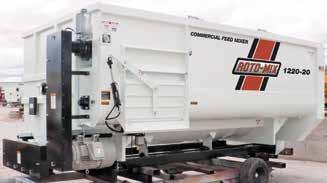


All of this will happen behind a backdrop of probable rising consumer prices — leading to evolving consumption habits in key markets.
However, it is not all about challenges. Opportunities will exist, even if they are more limited than in recent years.
Producers and processors will continue to be rewarded for efficiency, and agile companies with flexible production systems will continue to thrive. Progress should be made in biosecurity and animal health over the next year. Exporters should benefit from changing currency markets. And consumers should still place a priority on value-added products.
The report highlights key protein supply and demand trends across major producing areas:
• North America: Beef production should contract as it is predicted the U.S. cycle will turn and enter a multi-year decline. Poultry production should expand despite disease due to stronger demand, while pork production should stabilize.
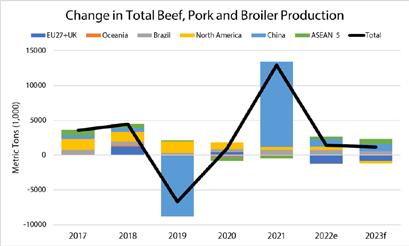
• Brazil: Expect beef production to continue to grow with stronger exports. Chicken and pork production are also set for expansion and export gains.
• Europe: Production is under pressure for all species. Disease risks remain elevated, market and regulatory-driven changes persist, and exports are in decline.
• China: Foodservice demand remains hampered by COVID-19 restrictions. Pork production continues to see marginal growth, and poultry sector expansion is possible, even with higher costs and production uncertainties.
• Southeast Asia: African Swine Fever risks are fading — allowing Vietnam and Philippines pork producers to rebuild. Poultry production is also slowly expanding as demand continues to recover from the pandemic.
• Australia and New Zealand: Gains in Australia beef and sheep meat production continue to expand with stronger prices, while New Zealand markets decline due to market pressures.
After exceptional gains in 2021, global animal protein production growth slowed in 2022. Given the many ongoing pressures facing global animal protein companies in 2023, change will be needed to maintain growth (Figure 1). Small gains should be prevalent in some regions, but contraction in Europe and North America will most likely undermine global growth.
Even with U.S. cow herd contraction leading global beef production into decline, Rabobank expects most global protein sectors to see production growth in 2023.

Aquaculture should again lead global production growth in the new year, while poultry should maintain its
relatively consistent long-term growth trend, even amid growing production costs (Figure 2).
While the margin pressure extending into 2023 is cyclical in nature, other drivers of change in production, such as sustainability and animal health, are more structural. In this context, it is possible 2023 marks an inflection point for global animal protein companies as they re-calibrate growth plans and trajectories given this outlook.
The report also examines critical issues facing global animal protein producers in the next year, including a global feed outlook, input cost
discussion, changing consumption patterns, ongoing biosecurity risks, and progress in sustainability measurements and reporting.
Rabobank Group is a global financial services leader providing wholesale and retail banking, leasing, and real estate services in more than 38 countries worldwide. Founded over a century ago, Rabobank today is one of the world’s largest banks with over $660 billion in assets. In the Americas, Rabobank is a premier bank to the food, agribusiness and beverage industry, providing sector expertise,
strategic counsel and tailored financial solutions to clients across the entire food value chain. Additional information is available on our website or on our social media platforms, including Twitter and LinkedIn.
Rabo AgriFinance, a subsidiary of Rabobank, is a leading financial services provider for farmers, ranchers and agribusinesses in the United States. To learn more about Rabo AgriFinance and its comprehensive suite of financial solutions, go to www.RaboAg.com.
www.NCBA.org NATIONAL CATTLEMEN 13
Challenges and Opportunities for Animal Protein in 2023
Figure 1. Provided by RaboResearch.
The Complete Feeding System Batch rations up to 1220 cu. ft. with a Roto-Mix Horizontal or up to 1300 cu. ft. with a Roto-Mix Vertical mixer. Combine the quick, gentle mixing action of a Roto-Mix Stationary with the efficient, cost effective delivery of a RDB belt floor or FDB chain floor delivery box to maximize profitability. Roto-Mix delivery boxes allow you to either match your feeder to the capacity of your stationary mixer, or with capacities up to 1900 cu.ft., choose to deliver multiple stationary batches in one trip! The combination of Roto-Mix stationary feed mixers and the correct size Roto-Mix feed delivery box make an accurate, efficient ration batching and delivery system. www.rotomix.com 620.225.1142 Call for more information! RCFB-systm
Figure 2. Provided by RaboResearch.
FEDERATION THROUGH THE DECADES
As the Federation of State Beef Councils celebrates its 60th anniversary this year, let’s step back in time and look at successful projects that have created a strong state/national partnership through the decades. This month, we travel to the groovy ‘60s when bell bottoms and tie-dye were all the rage, and the Federation was born.
Before the Beginning
Before we enter the ‘60s we need to go a little further back into history to understand how the Federation of State Beef Councils developed. In 1922, 14 organizations united to create the National Live Stock and Meat Board whose goal was to promote all red meats including beef, lamb and pork. The Meat Board brought together all segments of the value chain to improve consumer perception of meat. Funded by a voluntary 5 cents per carload assessment on train cars of animals sent to harvest, with an additional 5 cents requested from packers, it was agriculture’s first “checko ” program.
Power of Partnerships
With a limited initial budget, partnerships were essential, and the BIC joined with the American Dairy Association for a “Buttered Barbecued Steak” promotion and with the American National CowBelles (precursor to American National CattleWomen) in promoting “Beef for Father’s Day.” Through cooperation of state beef councils and state cattlemen’s groups, outdoor billboard and bumper sticker campaigns also encouraged consumers to “Enjoy Beef Every Day.”

As television sets were introduced into more homes, the BIC tested the power of television as a marketing medium. In 1964, the first television advertising campaign promoting beef occurred, with ten television commercials reaching more than 35% of all U.S. homes. The BIC also recognized early on Americans’ love of cookouts, and the first summer grilling campaign began. In 1966, BIC partnered with states to create and distribute 250,000 color brochures about grilling beef.






“For a state like Washington, we're a beef deficit state and that means we have more consumers than we have beef. We really have a limited Checko budget. And so, we benefit greatly from the investments that the largest beef cattle states have put into our national programs that we can then implement in our state successfully.”
--Patti Brumbach, Executive Director, Washington State Beef Commission (Established 1969)

Birth of the Federation
U.S.
cents President John F. Kennedy was assassinated
The world population was 3.21 billion
















































In the 1950s, states began organizing promotional campaigns and establishing groups dedicated to beef promotion. California started this trend in 1954, instituting a voluntary checko of 10 cents per head, 2 cents of which was forwarded to the Meat Board. Other states including Alabama, Montana and Florida also implemented state beef councils around the same time. Success of state programs spurred the development of the National Beef Council (NBC) in 1955 to solely promote beef at the national level.
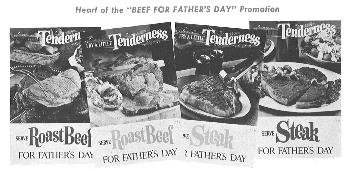
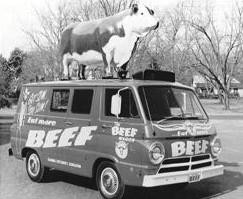


State Investments at Work
State beef councils recognized the importance of national programs and invested funds into the BIC. SBCs and BIC worked together to utilize each other’s expertise and leverage funding. By 1969, state beef councils raised nearly $2 million and were responsible for $800,000 of the Meat Board’s $1.4 million in revenue that year.
The average price of a new house was $12,650
The cost of a postage stamp was 4 cents
This investment structure was the beginning of the state-national partnership that still exists today. Sixty years later, the successful grassroots program continues, with the Federation relying on state beef councils for funding and input, and states relying on the Federation for support, advice and guidance on extending national programs locally.
For more information about the Federation of State Beef Councils, visit www.ncba.org/federation. Next month we’ll cruise into the ‘70s when beef was “Stayin’ Alive,” and disco was in full swing.
14 NATIONAL CATTLEMEN www.NCBA.org
Zip Codes were implemented in the
The NBC relied on voluntary contributions of 8 cents per head marketed. While more than 15 state beef councils formed in support of the NBC, the lack of funds limited the organization’s success.
As meat packing decentralized and producers focused on single-species operations, the Meat Board created species-oriented committees. In 1963, NBC merged with the National Live Stock and Meat Board and the Beef Industry Council (BIC) was formed, serving as both the national promotion arm of the beef industry and the headquarters of the Federation of State Beef Councils. Alcatraz Federal Penitentiary closed In 1963
Beefing Up Relationships with Healthcare Professionals
Today, more than ever, consumers are bombarded with information about the abundance of choices for what to wear, what to buy and what to eat. Whether through social media, television, radio or streaming services, grocery shoppers are constantly looking for information to help them make the best decisions for their families. And when it comes to nutrition information, there is one group that is turned to the most.
Registered Dietitian Nutritionists (RDNs) are the most frequently consulted health professionals for nutrition and healthy eating information, and 77% of global consumers declare that their advice impacts which foods they buy.1,2 Healthcare professionals, like RDNs, are a critical audience that the Beef Checkoff reaches with beef’s positive nutrition message, arming them with science-based information they can share with their patients and clients.
As NCBA, a contractor of the Beef Checkoff, kicks off fiscal year 2023 nutrition programming, they continue to find value in health professional education and outreach as this critical audience plays a key role in consumer health and nutrition. NCBA builds relationships with healthcare professionals through engagement at conferences and events; these relationships, and the information learned, help direct future content development.
In October 2022, the NCBA Nutrition Team partnered with Produce for Better Health to host a #BetterTogether reception during the Food and Nutrition Conference and Expo (FNCE) in Orlando, Florida. The networking event attracted more than 80 health professional attendees who gathered to collaborate on ways to pair beef and produce to optimize health and nutrition. As a result, new connections with nutrition influencers and thought leaders developed.
To continue the momentum gained at FNCE, the NCBA Nutrition Team
Attendees’ specialties ranged from pediatric nutrition and diabetes management to sports performance, and together they had a collective social media reach of more than 1.2 million. This well-connected, wellestablished, and influential group reaches consumers through media outlets such as Eat This, Not That!, CNBC, Yahoo! News and MSN.
Many of the connections established and strengthened at the FNCE #BetterTogether reception and “Meat-Up” have led to organic (unpaid) content development and engagement by nutrition influencers, including a myth busting video on YouTube and Instagram from Manuel Villacorta, MS, RD.
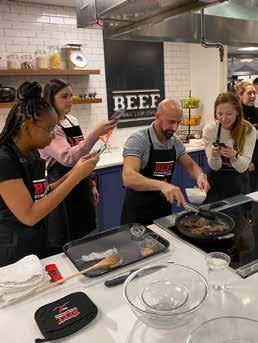
“We were excited to see that this experience encouraged nutrition influencers to share their newfound knowledge with their audiences, and we are looking forward to deepening and expanding these relationships throughout 2023,” said Shalene McNeill, PhD, RDN, NCBA’s executive director of Nutrition Science, Health & Wellness.
In addition to providing information about beef’s role in a healthy lifestyle to health professionals across the country, the Checkoff-funded Nutrition Seminar Program provides an opportunity to collaborate with state beef councils to place credentialed, expert speakers at statewide meetings for healthcare professionals. Currently, 22 credentialed experts are scheduled to speak at health professional education conferences in 2023. Many of these speakers were found through the #BetterTogether reception during FNCE.
The start of a new year is the perfect time to elevate the nutritional value of beef. February recognizes National Heart Health Month, and March highlights National Nutrition Month and National RD Day (March 15), providing perfect opportunities for nutrition influencer collaborations, health professional partnerships, Beef. It’s What’s For Dinner. produced content, recipe promotions and the launch of a new beef nutrition experts and advocates virtual community. For Heart Health Month, NCBA is also exploring partnerships with four nutrition influencers, all of which attended the FNCE #BetterTogether reception or the “Meat-Up.”
As the new year begins, NCBA is well positioned to continue providing sciencebased information and resources to health professionals, so they are ready to share beef’s positive health message with consumers across the country.

1. 1 International Food Information Council (IFIC) Foundation’s 2022 Food and Health Survey
2. 2 Eat Well Global, The Consumer Voice Report: Global Insights on Food, Trust, Nutrition and Influencer, November 2020
Beef Brings People Together for Tailgating
It’s no secret that the sound of beef sizzling on the grill and smoky smells wafting through the air draws people for tailgating fun. Tailgating is a feast for the senses and beef is what brings people together to celebrate.
No matter what the sport, fans drop their tailgates and roll out the grills for pre-event food and fun. Staff from the National Cattlemen’s Beef Association, a contractor of the Beef Checkoff, recently came together to create a tailgating atmosphere, complete with trucks, grills and beef to capture the sights and sounds for state beef councils to use in their promotional efforts.
The NCBA office parking lot was transformed into tailgating headquarters. Cameras rolled while beef grilled, and merriments ensued. The Beef. It’s What’s For Dinner. brand emblazoned across trucks, tables and
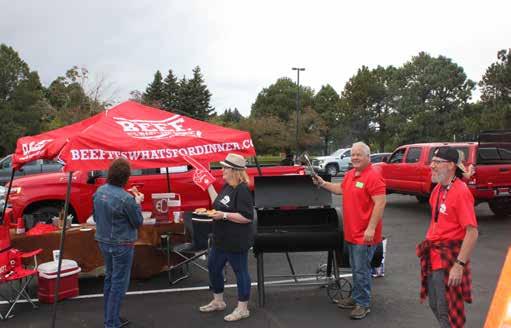
tents made it clear that beef was the protein of choice at this tailgate party. A variety of still photos and video were captured for use in advertisements, social media and other promotions throughout the year.
“We were able to develop highquality creative assets utilizing limited resources because we used our own talent and equipment,” said Don Waite, NCBA’s senior executive director of Federation State Services. “This type of innovative activity is what the state/national partnership is all about.”
This is one example of how the Federation of State Beef Council’s state-national partnership helps to create assets that benefit all state beef councils. The images and video captured at the event can be used by states in their efforts to promote beef at the local level.
SUSTAINABILITY IN THE SPOTLIGHT
GOOD NEWS FOR BEEF
Food
FOR MEAT ALTERNATIVES
www.NCBA.org NATIONAL CATTLEMEN 15
NEWS
hosted a three-day Nutrition Influencer “Meat-Up” in Denver to build relationships with 15 leading Registered Dietitian influencers and provide beef nutrition education sessions. Through a Beef Nutrition 101 presentation, a hands-on Culinary Education workshop, Social Media Masterclass and Beef Sustainability and Industry panel, attendees experienced multiple aspects of the beef industry and nutrition.
TRENDING IN FOOD & MEDIA ARMS #112922-09 1. National Cattlemen’s Beef Association. (2022). Traditional and social media listening dashboards Retrieved from Meltwater: www.meltwater.com 2. NielsenIQ, Answers on Demand, Monthly Protein Sales ending March 2022, Data processed 3/26/22 3. Consumer Beef Tracker, Directions Research, Analyzed by NCBA on behalf of the Beef Checkoff, 11/22/2022. With prices rising for poultry and falling for beef, media offered suggestions for alternative main dishes for Thanksgiving, and many encouraged swapping in beef.1 The Bureau of Labor Statistics tracks more than 200 spending categories. 90% of those categories are higher or the same as last year. Beef, televisions and smartphones are among the few items with lower prices compared to a year ago.1 IMPACT OF INFLATION
In recent months, news reports that included mentions of both methane and beef were up 88%. However, in recent weeks that trend has reversed. Despite an increase in coverage during the global COP 27 climate conference, overall mentions about methane and beef were down 46% in November.1
Several news outlets reported on new struggles for plant-based alternatives. The Wall Street Journal focused on alt-meat fever cooling while the New York Times mentioned the struggles for Beyond Meat.1
ISSUES
News coverage of cultivated meat spiked 86% in November compared to the previous month. The FDA said lab-grown meat is safe for human consumption. Meanwhile, CNN covered new efforts to create meat from thin air.
NEWS
Recent data from Information Resources Inc., or IRI, suggests that altmeat sales are declining in 2022, while analysis from Deloitte Consulting LLP. indicates that the market may already be saturated in the U.S. GOOD
FOR BEEF
trends for 2023 are putting a greater focus on sustainability. Upcycling and carbon neutrality are growing parts of the larger environmental conversation according to a report by SupHerb Farms.
Sales of beef are more than double those of chicken and quadruple those of pork throughout 2022.2 71% of consumers eat beef at least once per week.3 GOOD NEWS FOR BEEF
be used to produce
to
Beef fat will
80 million gallons of diesel fuel a year at a new facility in Nebraska. Construction is underway with production set
begin in 2024
Nominate














The Environmental Stewardship Award showcases cattle producers’ commitment to protecting the environment and improving fish and wildlife habitats while operating profitable cattle operations.













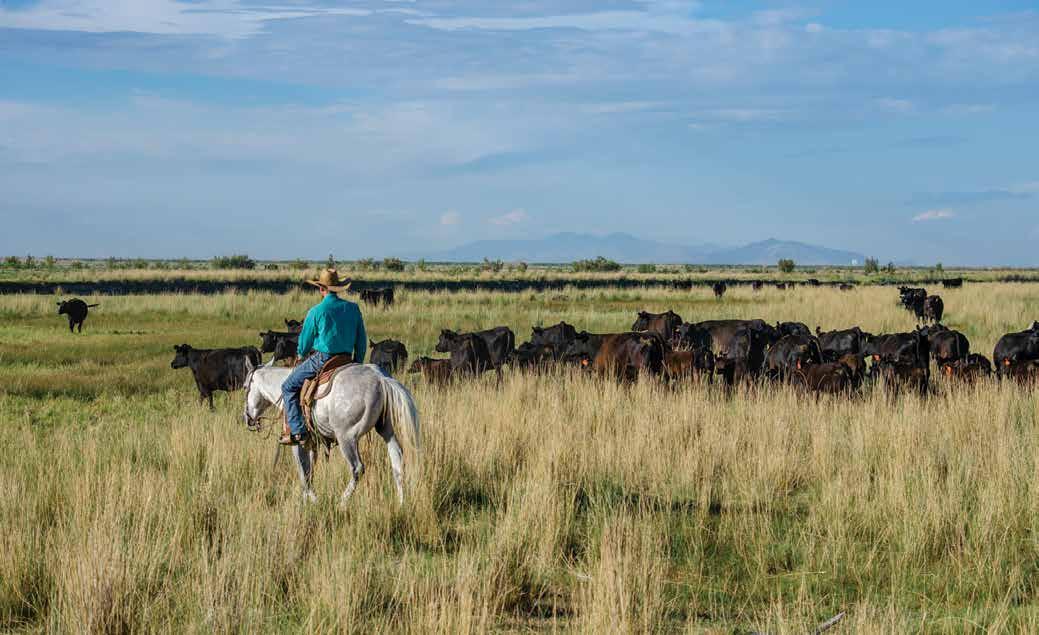
Help


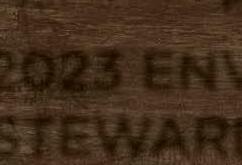





Your
FOR THE 2023 ENVIRONMENTAL STEWARDSHIP AWARD
Neighbor
INC.
us highlight the great work being done on cattle farms and ranches across the country by nominating your neighbor. NOMINATIONS ARE DUE MARCH 10, 2023 Nominations can be submitted by any organization, group, or individual on behalf of a U.S. cattle producer. Contact your state a liate, ESAP sponsor representative, or NCBA sta member for more information on submitting an application. For more information on how to get started, contact esap@beef.org or visit environmentalstewardship.org
























































































































